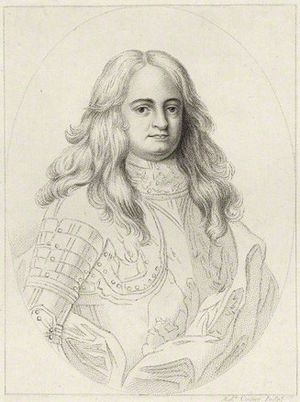Bernard Gascoigne facts for kids
Quick facts for kids
Sir
Bernard Gascoigne
|
|
|---|---|

Bernard Gascoigne, engraving by Robert Cooper
|
|
| Native name |
Bernardo Guasconi
|
| Born | 1614 Florence |
| Died | 10 January 1687 Haymarket, London |
| Buried | |
| Allegiance | Royalist |
| Battles/wars | |
Sir Bernard Gascoigne, also known as Bernardo Guasconi, was an Italian soldier born in Florence in 1614. He worked as a mercenary, which means he was a soldier who fought for money. He joined the Royalist army during the English Civil War.
He was captured in 1648 and almost executed, but he was set free. This happened because the Parliament did not want to upset a foreign country. After the war, he worked as a diplomat for England. He passed away in London in 1687.
Contents
Early Life and Military Career
Bernard Gascoigne was born in Florence, Italy, in April or May 1614. His father died when he was very young. He was then raised by his uncle.
As a young man, Gascoigne became a soldier. He served the Grand Duke of Tuscany. He fought in battles in Italy and Germany.
Serving in England
Gascoigne came to England around 1643 or 1644. He joined the army of King Charles I. This was during the English Civil War, where the King's supporters (Royalists) fought against Parliament.
In 1644, he surprised and captured some enemy officers. Later, in 1647, he wrote a report about the events in England for the Grand Duke of Tuscany.
The Siege of Colchester
In 1648, Gascoigne led a group of soldiers who took control of Colchester in Essex. This led to a long battle known as the Siege of Colchester. On August 28, the town surrendered. Gascoigne was captured.
He was sentenced to be shot the next day. However, his life was spared at the last moment. The leaders of Parliament did not want to execute a foreign officer. They worried it would cause problems with other countries.
After the War
After the war, King Charles II promised Gascoigne a pension. A pension is like a regular payment for past service. Gascoigne returned to Florence for a while.
He came back to England after 1660, when King Charles II was restored to the throne. He asked the King for a place to live in London instead of his pension. In 1661, there was an attempt to make him a British citizen, but it did not happen then. He later received a special document called a denization, which gave him some rights as an English subject. He was also knighted, becoming "Sir Bernard Gascoigne".
Return to Italy and Diplomatic Work
In 1664, Gascoigne traveled back to Tuscany. He wrote letters to English officials from Florence. He helped share information and connect people. When the English minister, Sir John Finch, visited Florence in 1665, he stayed at Gascoigne's house.
Second Time in England
Gascoigne returned to England in 1667. He became a member of the Royal Society of London, a famous group of scientists. He helped Italian scientists who visited London.
He also spent time with important people. In 1669, he was with Cosimo, Prince of Tuscany, during his visit to England. The next year, he joined the Queen and other ladies in a fun outing where they dressed as country girls.
Mission to Vienna
In 1672, Gascoigne was sent to Vienna, Austria. His job was to help arrange a marriage for James, Duke of York, who would later become King James II. James was supposed to marry Claudia Felicitas of Austria. However, the marriage plans did not work out. Gascoigne left Vienna in 1673.
Later Life and Death
Gascoigne received some money from the King in 1686. He passed away in London on January 10, 1687. He was buried in the parish of St Martin-in-the-Fields.
Writings
Bernard Gascoigne also wrote some books and reports:
- Relazione della Storia d' Inghilterra del mdcxlvii (Account of the History of England of 1647). This book was about the events in England and was sent to the Grand Duke of Tuscany. It was published in Florence in 1886.
- A Description of Germany. This report was about Germany's government and customs. He sent it to King Charles II in 1672. It was later published in a collection of state papers in 1702.

